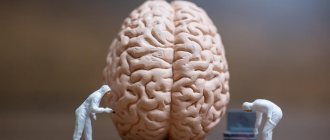Memory is an amazing human ability that never ceases to amaze researchers who study its features. Consisting of several levels, like floors, it allows you to retain only significant information. After listening to a lecture, watching a movie, talking with someone you know, try to reproduce in your head individual phrases that were said by the lecturer, movie character or interlocutor. Can you repeat them exactly? Unlikely unless you are eidetic.
This is because during a lecture, film show or conversation, short-term memory (abbreviated as KVP) was triggered, from which the main information (the topic of the report, the plot of the film or the essence of the conversation) migrated to the long-term. You didn’t set yourself the task of memorizing certain phrases exactly, so the thorough formulations disappeared. This is a big plus, because otherwise the memory would be full, and this, as a rule, leads to undesirable consequences.
The ability to filter information at this stage allows you not to fill your head with unnecessary things and leave enough space for something more important. To train it, you need to initially work on this “floor”.
What it is
Short-term memory is the retention of information for a short period of time. Experts say it is limited to 20-30 seconds. Moreover, the exact image begins to fade already at the 18th second, and by the 30th it completely disappears. Forgetting within a specified period of time occurs in the absence of targeted encoding and storage. If a person sets a goal to remember something, he transfers this information to the next “floor” of memory - long-term.
Short-term memory is the ability to retain information that we receive from life experiences and use to perform everyday, routine work. For example, a housewife washes the dishes, and it is the KVP that allows her to sort the plates into dirty and clean (I have already washed these), perform basic actions (I have already added detergent to the water, I have already soaked the frying pan, etc.).
A person does not even realize how important a role short-term memories play in his life. A striking example of their disorders is Alzheimer's disease. People suffering from it perform the same action several times in a row because they do not remember that they just performed it.
Since in psychology this is a kind of complex of cognitive abilities, experts argue that it can and should be trained and developed, which will allow you to remember a larger amount of information in the future.
Short-term memory. Principle of operation
As the name implies, memories are here for quite a short time - from a few seconds to several days. It happens like this:
The brain processes signals coming to it from various sources and stores them as long as they are needed for a task. The main mechanism for storing information at this stage is simple repetition. By stopping repetition, a person, as a rule, begins to forget what he remembers, thus freeing up space for storing new data that seems more relevant to him.
The capacity of short-term memory is also small. On average, this is 7 + -2 units of information - the Miller number, identified experimentally.
Stages
If a person does not set out to remember any specific information, short-term memory is triggered, and after 30 seconds he forgets it. But, when you need to retain an image for a longer period, memorization goes through 3 stages: encoding, storage and retrieval. If you want to train KVP, you need to know how all three work.
Stage 1. Coding
To retain an image in short-term memory, you first need to focus on it. All attention should be focused on what you need, and everything unnecessary that is happening around you at that moment is cut off and forgotten within 30 seconds.
For example, the goal is to remember the amount of the purchase you just made at the store. After a while, you will reproduce it, because you focused on it. But if you are asked what name was on the badge of the cashier who punched your check, or how many people were standing behind you in line, you are unlikely to be able to answer, because you do not need this information.
All people encode information in KVP differently:
- phonological (acoustic) encoding: to remember, you repeat information out loud or silently;
- visual: a stable association is created with the image seen; it is rarely used, since not many people have photographic memory.
The short-term memory “floor” consists of two rooms. In psychology, they are usually called storage facilities or buffers. Each of them is responsible for different brain structures. The first buffer is acoustic; all information that a person remembers by ear is sent there. It is located in the left hemisphere. The second is visual-spatial, where what was recorded with the help of vision is stored. It is located in the right hemisphere.
Stage 2. Storage
Long-term memory allows you to remember moments from childhood, school and college, some bright events from the past, poems and formulas memorized by heart, characters from your favorite films and the actors who played them. It seems that its storage is limitless and contains huge layers of information. The situation is completely different in the KVP.
It is clear that the amount of information stored in short-term memory is minimal. The amazing thing is that it can be expressed in mathematical terms. George Miller (an outstanding American psychologist) found that it is determined by the formula “7 ± 2”. According to his research, the average person retains only 7 elements in 30 seconds. Due to various reasons (individual characteristics, distractions), this number can range from 5 to 9.
You can test this rule for yourself. Quickly skim any list (names, movies, products), turn away and try to reproduce it. You can probably remember from 5 to 9 points.
Storing information in short-term memory is associated with two processes: consolidation and forgetting. If your task is to expand its scope, train it, you need to know what they are.
Enlargement
Your task is to remember the following sequence of letters in a short period of time: Sruoyylerecnis. A person who does not know English will reproduce from 5 to 9 characters. Anyone who has previously studied it can retrieve from the storage of long-term memory the once memorized phrase Sincerely Yours (translated as “Sincerely Yours”). It turns out that he combined 14 letters into 2 words that are easy to remember. You need to learn how to apply this method in practice, “pulling out” associations from memory that will reduce the amount of information to be stored.
Forgetting
Images from short-term memories are quickly forgotten for two reasons: extinction and replacement by new ones. Fading occurs because attention was not focused on this information. Even if you immediately encoded it (remembered the amount of the purchase in the store), as soon as you told it to someone or recorded it on paper, it will soon be erased by itself, as it will lose relevance. It may disappear from storage for another reason - if you need to remember this information every day, it is replaced by new facts. You probably remember how much you spent yesterday or the day before, but you are unlikely to reproduce the numbers from a week ago.
Stage 3. Reproduction
Recalling short-term memories seems to be a much easier process than recalling long-term ones. Indeed, in the latter case, they must first be found, then pulled out. And here the storage is very close - reach out and get it. However, the more elements there are in the buffers, the slower and less accurate the playback is. For example, if the phone consists of 10 digits, there is a high risk of making a mistake in at least one of them. If there are only 7 of them, this increases the chances of more accurate memorization (Miller’s “magic seven” works).
Those who train KVP should take this into account. Don't try to memorize too many elements at once. You need to increase the volume gradually.
With constant repetition (representation) of information, it is transferred from short-term memory to long-term memory.
Memory properties
Memory properties are influenced by parameters such as:
- age;
- regularity of brain activity accompanied by the use of memory;
- genetically determined characteristics of a particular individual;
- pathological processes that have a direct or indirect effect on brain function.
In accordance with the functional significance, the following memory properties are distinguished:
- accuracy (characterizes the correspondence of the received information to the reproduced);
- volume (characterizes the amount of data that the brain is able to record);
- speed of memorization (allows you to evaluate the efficiency of processing and recording information);
- speed of reproduction (talks about the brain’s ability to recreate once fixed information);
- rate of forgetting (characterizes the process of losing once received data).
Thanks to these properties of memory, it is possible to assess both the degree of its development and the severity of its impairments. Good memory is characterized, as a rule, by high rates of accuracy, volume and speed of memorization, in contrast to poor memory, when, along with a high rate of forgetting, a pronounced deterioration in the processes of processing and fixing material can be observed.
Kinds
Depending on how exactly encoding occurs in short-term memory, the latter is divided into several types.
Auditory / auditory
Memorization occurs through the organs of hearing. One point is important here: it is not enough just to hear the necessary information, it is advisable to say it out loud or to yourself. Otherwise, the image (phrase, word) will disappear after 30 seconds.
Visual/Visual
Memorization occurs through the organs of vision. To transfer a picture from short-term memory to long-term memory, you can use phonological coding (say to yourself or out loud several times what is depicted in it) or the association method.
Tactile/kinesthetic
Memorization occurs through touch. Few people have this type of memory. They need to hold the thing in their hands in order to record and retain information about it.
A person with short-term audio memory will be better at recalling information from lectures. Those who have a visual system, in order to retain the material, must see it on the board in the form of some diagrams or key points. Kinesthetic learners need practical exercises - laboratory work, experiments.
Based on the duration of information storage, short-term memory is also divided into instantaneous (after 15-20 seconds the image is erased) and operational, working (storing material for 30 seconds while a decision is made whether it is needed for further reproduction or not).
Exercises to develop short-term memory
To develop short-term memory, it is necessary to regularly train it with the help of special exercises aimed at strengthening both memory and attention.
Attention exercises
- Mental arithmetic Solve simple mathematical examples at speed within 3-5 minutes. This will help you learn to remember answers quickly and not get distracted.
- Correction tests Practice finding certain letters or symbols in a field with similar signs for speed.
- Find the Differences Practice finding the differences between pictures. This will teach you to be attentive to details.
Characteristics
- Volume
As already mentioned, the optimal capacity of an adult’s short-term memory is 7 elements. A slight deviation of ± 2 elements is allowed. At the same time, you need to understand that in this case, a plus is much better than a minus. If this parameter is less than 5, CVP violations are diagnosed, their cause is determined, recommendations for elimination are given (if possible), and treatment is prescribed.
- Filtration
Short-term memory shows a person’s ability to filter out unnecessary information that the world around us is full of. If during a lecture you are distracted by such moments as the color of a friend’s new blouse, the conversation of those sitting behind, music from the street from an open window, the educational material will not be learned, since the storage spaces will be filled with completely different images.
- Transfer to long-term
The volume and accuracy of long-term memory directly depends on short-term memory. If information is poorly encoded and stored in the KVP, it will remain just as deformed in the DVP, and the carrier will not understand this. This explains the constant debate on the topic: “I remember exactly that it was exactly like that” - “No, everything happened differently.” People remember the same event in different ways and consider their own version to be reliable.
Content
- Short-term memory. Principle of operation
- The difference between short-term memory and working and long-term memory types
- Other types of memory
- Recommendations for improving short-term memory
- Exercises to develop short-term memory
If you've ever studied for an exam in one or two nights, you know how much information the human brain can hold, and how quickly what is memorized is forgotten later. This is how one of our types of memory works—short-term memory.
Short-term memory is an intermediate “storage” of data in which information entering the brain is stored before it is transferred to long-term storage or is completely forgotten.
Violations
Short-term memory problems need to be addressed immediately because they have much more serious consequences than long-term memory problems. When a person does not remember what happened 5 years ago, it is excusable. But when he forgets what he did 5 minutes ago, it turns into a disaster not only for himself, but also significant difficulties for the people around him.
Causes
Loss or damage to short-term memory can be caused by the following factors:
- depression disrupts the chemical and hormonal balance in the brain structures, causing the ability to concentrate to be lost;
- ischemic stroke leads to problems with cerebral circulation;
- mental trauma: the central nervous system blocks the storage of painful information, which is associated with a state of affect, when after a severe stressful situation a person does not remember what happened in those few minutes;
- head injuries lead to a temporary deterioration of the CV;
- Drug addiction, alcoholism, and smoking do not allow the brain to receive the required amount of oxygen, which is why those parts of it that are responsible for the central nervous system suffer.
The disorder can also be caused by vitamin deficiency, uncontrolled or long-term use of powerful medications, insomnia, thyroid problems, Alzheimer's disease, severe infections (HIV, tuberculosis, syphilis) and other physiological factors.
Symptoms
What are some signs that indicate you have problems with short-term memories?
- lack of logic in thinking, confusion of thoughts and consciousness, progressive dementia;
- blurred vision: blurry pictures, circles and spots before the eyes;
- depression;
- decreased cognitive abilities: the processes of perception, learning and thinking are disrupted;
- impaired motor coordination, muscle spasms.
Poor short-term memory leads to problems in learning and significantly reduces the quality of life, so it should be constantly trained and improved. If serious impairments are diagnosed, this can deprive a person of the ability to perform routine work and live their normal life.
Related article: Memory disorders
Where does memory live? Where are memories stored?
Although memories are not stored in a specific place, but are distributed in a system of neural connections, different parts of the brain play a predominant role in one type of memory or another.
- The dorsolateral parts of the prefrontal cortex are primarily responsible for working memory;
- Episodic memory is associated with the function of the hippocampus (translated from Greek as “seahorse”), the medial nuclei of the thalamus, and the mediobasal frontal regions;
- Semantic memory is associated with the function of the posterior inferior temporal and temporo-occipital regions of the brain;
- Procedural is associated with the function of the premotor cortex of the frontal lobe, subcortical gray ganglia and cerebellum;
- A special area on the fusiform gyrus involved in face recognition;
- Amygdala (memory of emotional events)
Diagnostics
Testing short-term memory can be carried out in several directions:
- volume measurement;
- determining the duration of information storage;
- study of the processes of memorization, preservation and reproduction.
For each of these areas there is its own determination method.
Volume:
- classic Jacobs test;
- measurement of the KVP index using the Muchnik and Smirnov method;
- partial reproduction, Sperling method;
- recoding information using the method of Vuchetich and Zinchenko;
- determination of the missing link using the Buschke method;
- subthreshold accumulation of stimulus energy according to the method of Virgiles and Zinchenko.
The duration is determined using the Hinrichs guessing method.
Memorization process:
- retained members of the series according to the Ebbinghaus method;
- equalization in memorization, Wurdworth's method;
- successful responses and paired associations, developed by Müller and Pilzecker;
- anticipation, anticipating the reproduction of a series;
- mental labyrinth Persona;
- pictograms, Vygotsky's method;
- double stimulation, developed by Luria and Leontiev.
The conservation process is determined using the Ebbinghaus method.
To study the reproduction process, the following methods are used:
- sequential playback;
- a given standard;
- reconstruction;
- saving.
Within the framework of each of the mentioned methods, a valeological assessment of short-term memory is carried out, that is, taking into account physiological factors: age, gender, the presence of chronic diseases, well-being at the time of the test. To obtain more accurate data, studies are organized several times.
The most famous method for determining the volume of the CVF is the Jacobs test.
There are 4 sets of numbers, each of which has 7 rows, starting with 4 elements and ending with 10. They look like this:
The tester reads each number at intervals of 1 second, after each row pauses for 2-3 seconds and allows the subjects to write down what they remember. Between sets, a rest of 5-6 minutes is given.
At the end of the test, the volume of the KVP is calculated using the formula: PC (volume of short-term memory) = A (the maximum length of the series that was reproduced without errors for each set) + C (the number of series that were correctly reproduced and exceed the value A): 4 (the number sets).
The results obtained allow us to draw the following conclusions:
How to develop?
It is necessary to develop memory throughout life. This is necessary in order to avoid Alzheimer's, Parkinson's, Pick's and memory loss in old age. The cognitive function of the brain is plastic, so it lends itself well to development and training.
You can improve your memory using various techniques:
- Aivazovsky’s method involves detailing each image;
- Cicero’s method makes it possible to sort all the information in the brain’s archive into shelves;
- memorizing texts, songs, poems;
- associative memory games;
- solving Scandinavian and Japanese crosswords;
- unraveling logical computer puzzles;
- verbal-logical methods, alphanumeric code, various associative connections, methods of “places” and “hangers” in mnemonics;
- training attention and thinking using certain exercises.
To maintain excellent memory, experts recommend leading an active and healthy lifestyle, eating right, providing yourself with adequate sleep, spending more time in the fresh air, playing sports, avoiding excessive stress and stressful situations, maintaining a daily routine and developing intelligence by reading books and playing chess. and other ways.
You can learn more about memory development from the video below.
Long-term memory
A person’s ability to store information for a very long period of time, sometimes limited only by the duration of our life, is called long-term memory. It assumes that people have the ability, at any necessary moment, to remember and reproduce what was once firmly settled in their consciousness.
A person is able to tell an unlimited number of times without losing the meaning and all the smallest details of information stored in long-term memory storage. Systematic repetition allows you to retain data in your head longer and longer.
The functioning of long-term memory is associated with processes such as thinking and willpower. They are necessary in order to find once stored information in the depths of consciousness. In order for data to move into long-term memory, a clear commitment to memorization is needed, as well as systematic repetition.
All people have this type of memory developed to varying degrees. The better the long-term memory, the more units of information a person can remember with fewer repetitions.











